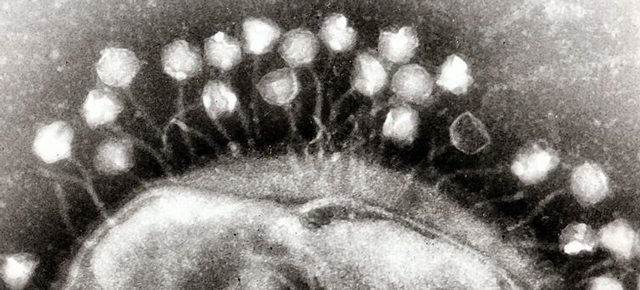Today, scientists report the discovery of an incredibly common new virus that lives inside human gut bacteria. It’s called crAssphage (more on the name later!), and it’s about six times more abundant than all other known bacterial viruses put together. How did we miss it for so long?
The oversight might seem especially strange considering how intensely our the gut microbiome have been scrutinized lately. While most of that attention has focused on bacteria, the microbiome actually includes viruses — and fungi — too. The viruses most familiar to us are the ones that make us sick — flu, herpes, chicken pox — but crAssphage and other viruses living in our guts actually attack bacteria, not humans. They’re called bacteriophages, or just phages, for short.
The reason we didn’t find crAssphage is because we didn’t know to look for it. Let’s go through the chicken-and-the-egg problem here.
While new sequencing technologies have gotten way faster and cheaper, they still have a weakness: they’re great for finding things we already know to look for, but they’re lousy at finding new organisms. When researchers analyse a stool sample, they get a soup of all the DNA fragments from the sample — bacterial, viral, and human alike. Then there’s the computationally intensive task of assembling those fragments into sequences we can identify. If particular bacteria has a particular string of genetic, then hey, we’ve found that bacteria in the sample.
The problem is that if we don’t already know the sequence of an unknown virus, we can’t find it with this technique. In fact, Bas Dutilh, an author of this new crAssphage study, says something like 75 per cent of the DNA sequences in a new stool sample are unknown. Science journalist Ed Yong does an excellent job of explaining how Dutilh got around the problem:
Dutilh’s team found it by using a different approach based on a simple idea: that fragments which repeatedly turn up in the same samples are more likely to be parts of the same genome. They used a technique called cross-assembly to identify one such group of co-occurring sequences, in stool samples from 12 people. They then assembled these sequences into a single genome.
So there you have it: crAssphage, so named for the cross-assembly technique that led to its discovery. Dutilh’s team did a bit more work to verify that crAssphage specifically lived off of Bacteroides, a common group of bacteria in our guts.
In all, the team found crAssphage in the 75 per cent of the gut sequences they studied from people in the US, Europe and South Korea. We’re still not sure exactly what phages in our gut do, but they definitely play a role in the gut microbial ecosystem. A study last year suggested phages help keep invading bacteria in check.
For now, I’ll just leave with with an incredible number: scientists estimate there are 100 times more viral particles than human cells in your body. So there’s still a lot to learn about what we really are. [Nature Communications via Not Exactly Rocket Science]
Picture: bacteriophages around a bacterial cell. GrahamColm/Wikipedia Commons
